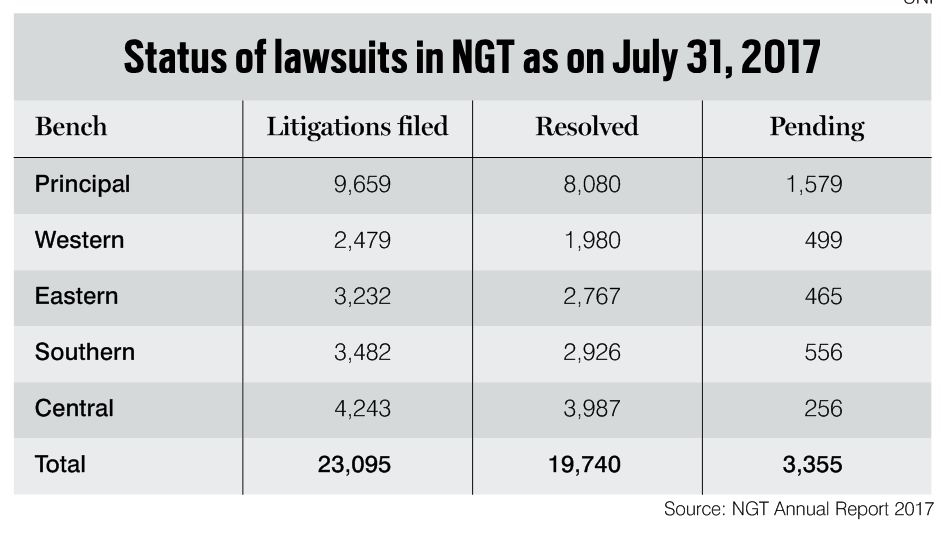
Above: NGT has been functioning sans a chairperson since Justice Swatanter Kumar (left) retired in December 2017/Photo: Anil Shakya
Staff crisis has led some of the benches of the National Green Tribunal discontinuing hearings in environment cases
~By Punit Mishra
The National Green Tribunal has been hit by a severe staff shortage. When Justice Swatanter Kumar retired as chairperson of NGT on December 20, 2017, Justice Umesh Dattatraya Salvi was made acting chairperson. He retired on February 13, 2018, without passing the baton to anyone else. There are media reports that Justice Amitava Roy, who superannuated as a judge of the Supreme Court, is likely to be appointed as chairperson.
This sorry state of affairs exposes the severe staff shortage at the green panel. Ironically, though the NGT has a sanctioned strength of a maximum of 20 judicial members and a minimum of 20 expert members, the reality is that there are only four judicial and two expert members for all the five benches of NGT, including the principal one in Delhi.
SINGLE-JUDGE BENCHES
The staff shortage has forced the Tribunal’s western region bench in Pune to discontinue hearings after a Supreme Court order on January 31 stated that no single-judge bench is allowed to preside over hearings at NGT.
“Let us tell you very candidly. We cannot allow single-judge benches (at NGT). Benches should consist of one technical member, one judicial member each,” a bench headed by Chief Justice Dipak Misra and comprising Justices AM Khanwilkar and DY Chandrachud had said. They were acting on a petition filed by the NGT Bar Association challenging the constitutional validity of the NGT (Practices and Procedures) Amendment Rules, 2017, which allowed even a single-member bench to perform judicial functions.

The situation is the same for NGT’s Chennai bench which stopped hearings from January 3, 2018, due to a shortage of judicial and expert members.
The Kolkata bench, too, is reeling from a big shortage of expert members. This has left thousands of litigants high and dry and delayed cases pertaining to compensation to victims of pollution and farmers, forest diversion, power plants, mining, dams and metro projects.
Instead of filing up the current vacancies, the Ministry of Environment, Forests and Climate Change (MoEF) on December 1, 2017, brought into effect the National Green Tribunal (Practices and Procedure) Rules, which stated that in special circumstances, the chairperson may appoint a single-member bench. The rules go contrary to the very spirit of the National Green Tribunal Act, 2010, which clearly says that the bench should comprise at least one expert and one judicial member.
COURTS TAKE NOTICE
Courts too have time and again reminded the government to fill up the vacancies. In September 2017, the Delhi High Court bench of Acting Chief Justice Gita Mittal and Justice C Hari Shankar had asked the government to hasten the process of appointments at NGT. It was acting on a case filed by a Gaurav Bansal who had sought the filling up of NGT’s vacancies and asked the centre to file a status report on the appointments.
The plea said: “Non-appointment of NGT members also amounts to interference in the independence of judiciary. More so, the idea of having specialised tribunals adjudicating upon matters of particular fields would be defeated if the tribunals are not given the manpower and resources to diligently discharge their functions and duties.” It added that the NGT was heading towards a premature death due to bureaucratic red tape.
The apex court, too, had expressed concern over the impending vacancies at NGT. In December 2017, a Supreme Court bench headed by Chief Justice of India Dipak Misra had sought an answer from the centre with regard to the non-filling of vacancies in NGT’s principal and zonal benches. The centre then had informed the Lok Sabha that it had constituted a selection-cum-search committee for the vacant posts.
APPOINTMENT ISSUE
Speaking to India Legal, former Acting Chief Justice of Gauhati High Court K Sreedhar Rao reckoned that this should be resolved at the earliest. “Appointments at NGT are overseen by the chairperson and he recommends the names of judges to be appointed to a panel of Supreme Court judges and they pass on the recommendations to the Chief Justice who then finalises the names. The vacancies are duly advertised on the recommendations of the chairperson and judges who are willing can apply,” said Justice Rao. The process of appointments is not cumbersome, he added. When asked whether a single member-bench should be allowed in NGT, Justice Rao said there was no harm as in many high courts, single member-benches were operating.
Attempts by India Legal to contact Justice Swantanter Kumar were futile. Law experts rued the staff shortage in a Tribunal which gave landmark judgments such as holding the Art of Living responsible for destroying the ecology of Yamuna floodplains in Delhi and banning 10-year-old diesel and 15-year-old petrol vehicles and giving strict orders to control pollution in the Ganga and Yamuna.
Justice Swantanter Kumar himself had noted that the green panel had evolved as a globally acclaimed institution over the years. “What satisfies me the most is that the NGT has succeeded in expanding environment consciousness. Today the environment consciousness and awareness created by the Tribunal is its biggest contribution. We’ve been able to give inexpensive and expeditious justice… cases are disposed of within the same year or two years… The dispensation of environment justice at the tribunal has been very consistent,” Justice Kumar has said on his retirement.


